auto HONDA CR-V 2002 RD4-RD7 / 2.G Owners Manual
[x] Cancel search | Manufacturer: HONDA, Model Year: 2002, Model line: CR-V, Model: HONDA CR-V 2002 RD4-RD7 / 2.GPages: 372, PDF Size: 4.49 MB
Page 9 of 372
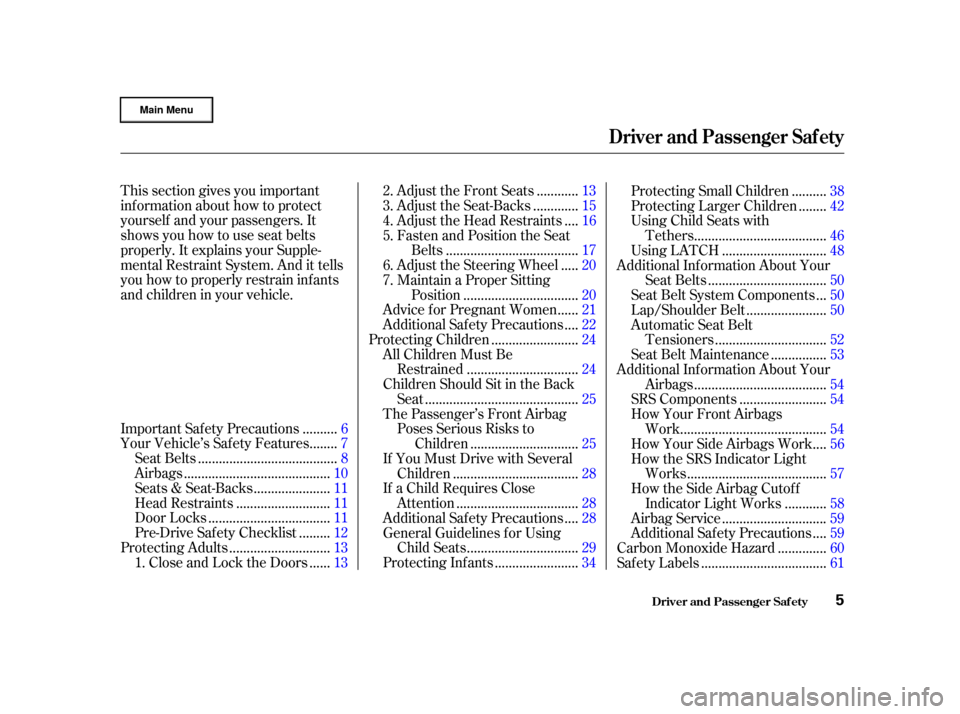
This section gives you important
inf ormation about how to protect
yourself and your passengers. It
shows you how to use seat belts
properly. It explains your Supple-
mental Restraint System. And it tells
you how to properly restrain inf ants
and children in your vehicle..........
Important Safety Precautions . 6
.......
Your Vehicle’s Saf ety Features . 7
.......................................
Seat Belts .8
.........................................
Airbags .10
.....................
Seats & Seat-Backs .11
..........................
Head Restraints .11
..................................
Door Locks .11
........
Pre-Drive Saf ety Checklist . 12
............................
Protecting Adults .13
.....
1. Close and Lock the Doors . 13 ...........
2. Adjust the Front Seats . 13
............
3. Adjust the Seat-Backs . 15
...
4. Adjust the Head Restraints . 16
5. Fasten and Position the Seat .....................................
Belts .17
....
6. Adjust the Steering Wheel . 20
7. Maintain a Proper Sitting ................................
Position .20
.....
Advice f or Pregnant Women . 21
...
Additional Safety Precautions . 22
........................
Protecting Children .24
All Children Must Be ...............................
Restrained .24
Children Should Sit in the Back ...........................................
Seat .25
The Passenger’s Front Airbag Poses Serious Risks to ..............................
Children .25
If You Must Drive with Several ...................................
Children .28
If a Child Requires Close ..................................
Attention .28
...
Additional Safety Precautions . 28
General Guidelines f or Using ...............................
Child Seats .29
.......................
Protecting Inf ants .34 .........
Protecting Small Children . 38
.......
Protecting Larger Children . 42
Using Child Seats with .....................................
Tethers .46
.............................
Using LATCH .48
Additional Inf ormation About Your .................................
Seat Belts .50
..
Seat Belt System Components . 50
......................
Lap/Shoulder Belt .50
Automatic Seat Belt ...............................
Tensioners .52
...............
Seat Belt Maintenance . 53
Additional Inf ormation About Your .....................................
Airbags .54
........................
SRS Components .54
How Your Front Airbags .........................................
Work .54
...
How Your Side Airbags Work . 56
How the SRS Indicator Light .......................................
Works .57
How the Side Airbag Cutof f ...........
Indicator Light Works . 58
.............................
Airbag Service .59
...
Additional Safety Precautions . 59
.............
Carbon Monoxide Hazard . 60
...................................
Saf ety Labels .61
Driver and Passenger Saf ety
Driver and Passenger Saf ety5
Page 11 of 372
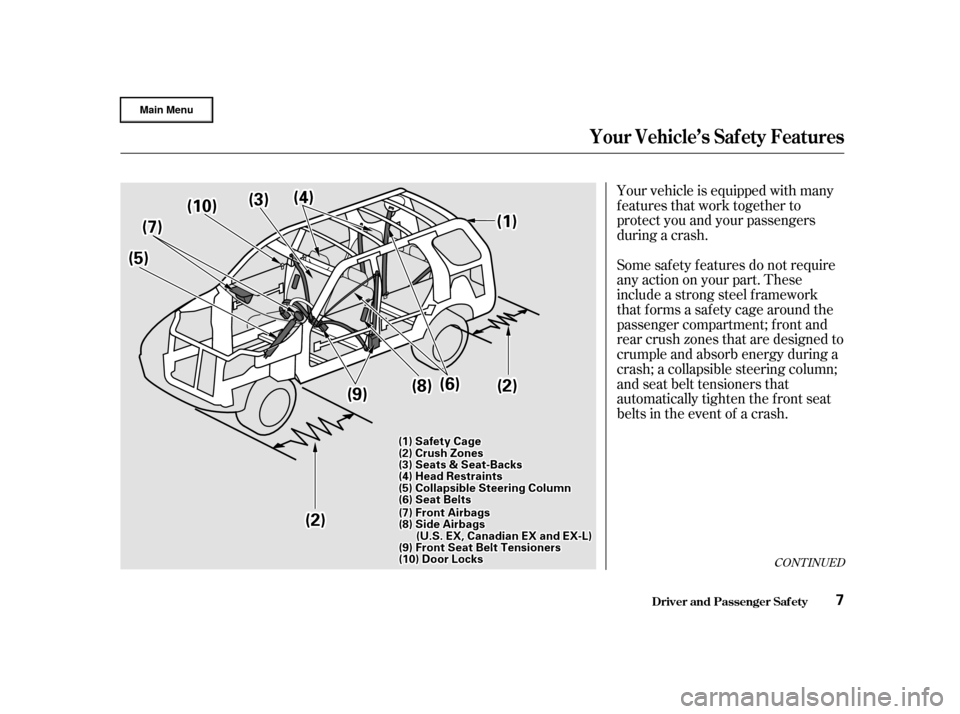
Your vehicle is equipped with many
features that work together to
protect you and your passengers
during a crash.
Some saf ety f eatures do not require
anyactiononyourpart.These
include a strong steel f ramework
that forms a safety cage around the
passenger compartment; f ront and
rear crush zones that are designed to
crumple and absorb energy during a
crash; a collapsible steering column;
and seat belt tensioners that
automatically tighten the front seat
belts in the event of a crash.
CONT INUED
Driver and Passenger Saf ety
Your Vehicle’s Saf ety Features
7
( (4
4) )
(
( 7
7) )
(
( 5
5) )
(
(9
9) ) (
(
1
1) )
(
( 8
8) ) (
(
6
6) )
(
(2
2) )
(
(
3
3) )
(
( 1
10 0))
(
(2
2) )
(
(1
1) ) S
Sa affe
et tyy C
Caagg e
e
(
( 2
2) ) C
Cr ruu s
shh Z
Zo
on
ne
ess
(
( 3
3) ) S
Se eaattss &
& S
Seeaatt--B
Ba acckks s
(
( 4
4) ) H
H e
eaadd R
Reessttrraai inn t
tss
(
( 5
5) ) C
Co ol
lllaap p s
siibb l
lee S
Stteee erriinn g
g C
Cool
luu m
m n
n
(
( 6
6) ) S
Se eaatt B
Be elltts s
(
( 7
7) ) F
Frroo n
nt
t A
A i
irrb b a
agg s
s
(
( 8
8) ) S
Si idd e
e A
Ai
irrb b a
agg s
s
(
( U
U. .SS. .E
E X
X ,
,C
Ca ann a
add i
iaan n E
EX
X a
ann d
d E
EX
X -
-L
L) )
(
( 9
9) ) F
Frroo n
nt
t S
Se eaatt B
Be elltt T
Te
enn s
siioo n
ne
errss
(
( 1
10 0)) D
D o
oo
or
r L
Loo c
ckks s
Page 54 of 372
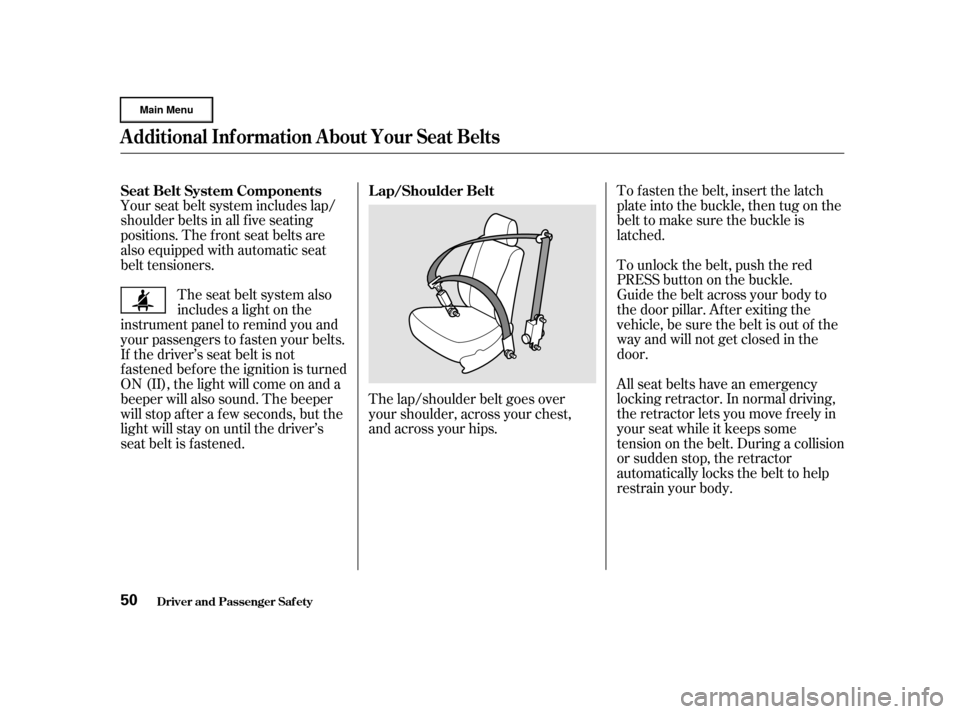
Your seat belt system includes lap/
shoulder belts in all f ive seating
positions. The f ront seat belts are
also equipped with automatic seat
belt tensioners.To fasten the belt, insert the latch
plate into the buckle, then tug on the
belt to make sure the buckle is
latched.
To unlock the belt, push the red
PRESSbuttononthebuckle.
Guide the belt across your body to
the door pillar. Af ter exiting the
vehicle, be sure the belt is out of the
way and will not get closed in the
door.
All seat belts have an emergency
locking retractor. In normal driving,
the retractor lets you move f reely in
your seat while it keeps some
tension on the belt. During a collision
or sudden stop, the retractor
automatically locks the belt to help
restrain your body.
The seat belt system also
includes a light on the
instrument panel to remind you and
your passengers to f asten your belts.
If the driver’s seat belt is not
fastened before the ignition is turned
ON (II), the light will come on and a
beeper will also sound. The beeper
will stop af ter a f ew seconds, but the
light will stay on until the driver’s
seat belt is f astened. The lap/shoulder belt goes over
your shoulder, across your chest,
and across your hips.
Seat Belt System Components L ap/Shoulder Belt
Additional Inf ormation About Your Seat Belts
Driver and Passenger Saf ety50
Page 56 of 372
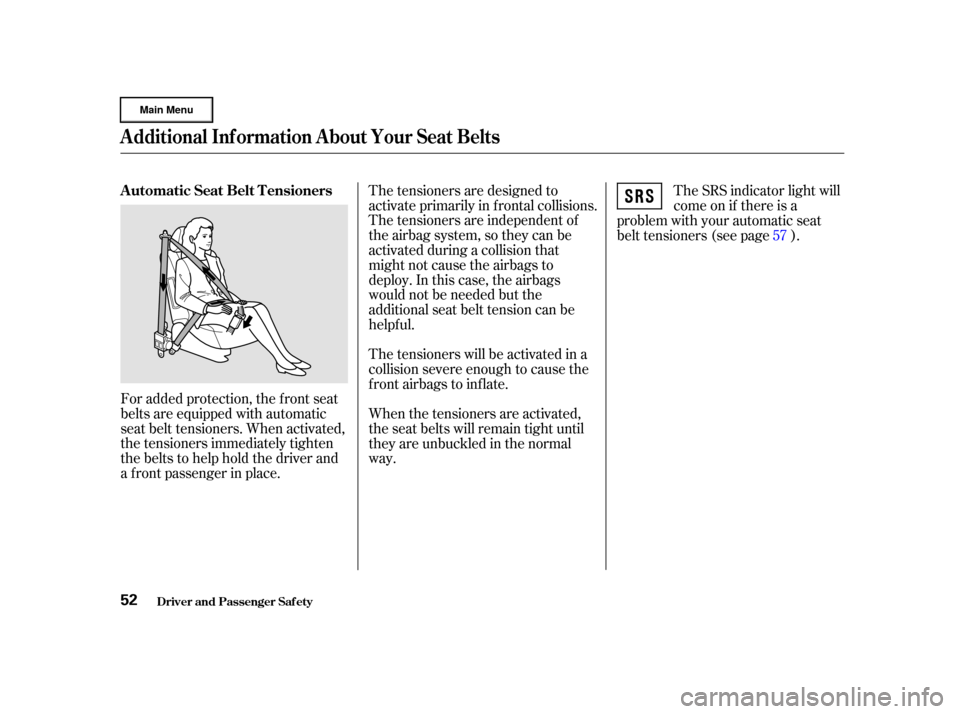
For added protection, the f ront seat
belts are equipped with automatic
seat belt tensioners. When activated,
the tensioners immediately tighten
the belts to help hold the driver and
a f ront passenger in place.The tensioners are designed to
activate primarily in f rontal collisions.
The tensioners are independent of
the airbag system, so they can be
activated during a collision that
might not cause the airbags to
deploy. In this case, the airbags
would not be needed but the
additional seat belt tension can be
helpf ul.
The tensioners will be activated in a
collision severe enough to cause the
f ront airbags to inf late.
When the tensioners are activated,
the seat belts will remain tight until
they are unbuckled in the normal
way.
The SRS indicator light will
come on if there is a
problem with your automatic seat
belt tensioners (see page ). 57
Additional Inf ormation About Your Seat Belts
Driver and Passenger Saf ety
A utomatic Seat Belt T ensioners
52
Page 57 of 372

If a seat belt is worn during a crash,
it must be replaced by the dealer. A
belt that has been worn during a
crash may not provide the same level
of protection in a subsequent crash.
The dealer should also inspect the
anchors f or damage and replace
them if needed.
Automatic seat belt tensioners that
deployed during a crash must be
replaced.
For inf ormation on how to clean your
seat belts, see page .
For saf ety, you should check the
condition of your seat belts regularly.
Pull each belt out f ully and look f or
f rays, cuts, burns, and wear. Check
that the latches work smoothly and
that the lap/shoulder belts retract
easily. Any belt not in good condition
or not working properly will not
provide good protection and should
be replaced as soon as possible.
Honda provides a lif etime warranty
on seat belts. Honda will repair or
replace any seat belt component that
f ails to f unction properly during
normal use. Please see your
booklet f or
details. 302
Honda
Warranty Inf ormation
Seat Belt Maintenance
U.S. Models
Additional Inf ormation About Your Seat Belts
Driver and Passenger Saf ety53
Not checking or maintaining
seat belts can result in serious
injury or death if the seat belts
do not work properly when
needed.
Check your seat belts regularly
and have any problem
corrected as soon as possible.
Page 58 of 372

Your Supplemental Restraint System
(SRS) includes:An indicator light on the
instrument panel that alerts you to
a possible problem with the
system (see page ).
Emergency backup power in case
your vehicle’s electrical system is
disconnected in a crash.
Two f ront airbags. The driver’s
airbag is stored in the center of
the steering wheel; the f ront
passenger’sairbagisstoredinthe
dashboard. Both are marked ‘‘SRS
AIRBAG.’’
Automatic seat belt tensioners
(see page ).
Sensors that can detect a
moderate to severe frontal
collision.
If you ever have a moderate to
severe f rontal collision, the sensors
will detect the vehicle’s rapid
deceleration If the rate of
deceleration is high enough, the
control unit will instantly inf late the
front airbags and activate the
automatic seat belt tensioners.
A sophisticated electronic system
that continually monitors and
records inf ormation about the
sensors, the control unit, the
airbag activators, and driver and
passenger seat belt use when the
ignition is ON (II). 52
57
SRS Components
How Your Front A irbags Work
Additional Inf ormation About Your Airbags
Driver and Passenger Saf ety54
Page 61 of 372
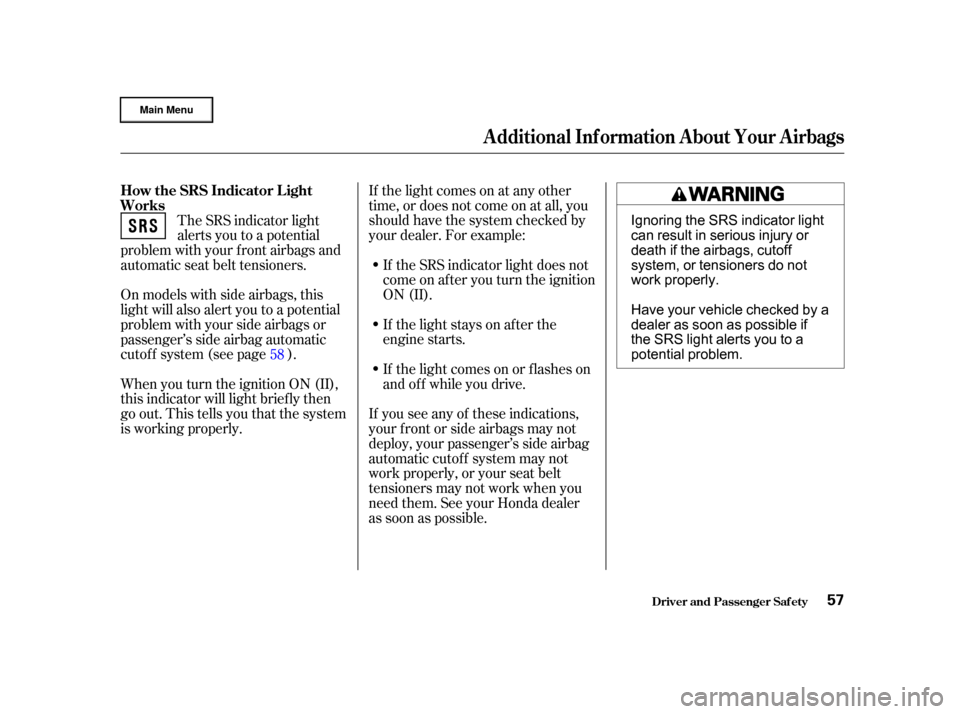
If the light comes on at any other
time, or does not come on at all, you
should have the system checked by
your dealer. For example:If the SRS indicator light does not
come on after you turn the ignition
ON (II).
If the light stays on after the
engine starts.
If the light comes on or f lashes on
andoff whileyoudrive.
The SRS indicator light
alerts you to a potential
problem with your f ront airbags and
automatic seat belt tensioners.
On models with side airbags, this
light will also alert you to a potential
problem with your side airbags or
passenger’s side airbag automatic
cutof f system (see page ).
When you turn the ignition ON (II),
this indicator will light brief ly then
go out. This tells you that the system
is working properly. If you see any of these indications,
your f ront or side airbags may not
deploy, your passenger’s side airbag
automatic cutoff system may not
work properly, or your seat belt
tensioners may not work when you
need them. See your Honda dealer
as soon as possible.
58
How the SRS Indicator L ight
Works
Additional Inf ormation About Your Airbags
Driver and Passenger Saf ety57
Ignoring the SRS indicator light
can result in serious injury or
death if the airbags, cutoff
system, or tensioners do not
work properly.
Have your vehicle checked by a
dealer as soon as possible if
theSRSlightalertsyoutoa
potential problem.
Page 62 of 372

A f ront seat passenger should not
use a cushion or other object as a
backrest. It may prevent the cutof f
system f rom working properly.
When you turn the ignition ON (II),
the indicator should light brief ly and
goout(seepage ).Ifitdoesn’t
light, stays on, or comes on while
driving without a passenger in the
f ront seat, have the system checked.
If a small-statured adult leans
sideways, or larger adult slouches
and leans sideways into the
deployment path of the side airbag,
the system may also shut of f the side
airbag.
If the side airbag cutof f indicator
light comes on, you should have the
passenger sit upright. Once the
passenger is out of the deployment
path of the side airbag, the system
will turn the airbag back on and the
light will go out.
To reduce the risk of injury f rom an
inf lating side airbag, your vehicle has
an automatic cutoff system for the
passenger’s side airbag.
Although Honda does not encourage
children to ride in the f ront, this
system is designed to shut of f the
side airbag if a child leans sideways
and the child’s head is in the side
airbag deployment path. If does not mean there is a problem
with your side airbags. It means that
thesideairbagcutoff systemhas
activated to prevent the side airbag
f rom deploying. This light alerts you that
the passenger’s side airbag
has been automatically shut of f . 67
Only on models equipped with side
airbags
Additional Inf ormation About Your Airbags
Driver and Passenger Saf ety
How the Side Airbag Cutof f
Indicator L ight Works
58
Page 63 of 372

Together, airbags and
seat belts provide the best
protection.
Tampering could cause
the airbags to deploy, possibly
causing very serious injury. See page f or f urther inf ormation
and precautions relating to your
airbags.
If rain or spilled water
soaks into a seat-back, it can
prevent the side airbag system
f rom working properly. Improperly
replacing or covering f ront seat-
back covers can prevent your side
airbags f rom inf lating during a
collision.
Any
airbag that has deployed must be
replaced along with the control
unit, automatic seat belt
tensioners, and other related parts.
Do not try to remove or replace
anyairbagbyyourself.Thismust
be done by a Honda dealer or a
knowledgeable body shop.
Your f ront and side airbag systems
(if equipped) are virtually
maintenance-f ree, and there are no
parts you can saf ely service.
However, you must have your
vehicle serviced if:
Take your vehicle to
an authorized Honda dealer as
soon as possible. If you ignore this
indication, the airbags might not
inf late when you need them. 192
Airbag Service
Additional Saf ety Precautions
Donotattempttodeactivateyour
airbags.
Do not t amper wit h airbagcomponent s or wiring f or anyreason.
Do not expose t he f ront seat -backsto water. Do not cover or replace f ront seat -
back covers wit hout consult ing aHonda dealer.
Your airbags ever inf late.
T he SRS indicat or light alert s yout o a problem.
Additional Inf ormation About Your Airbags
Driver and Passenger Saf ety59
Page 71 of 372
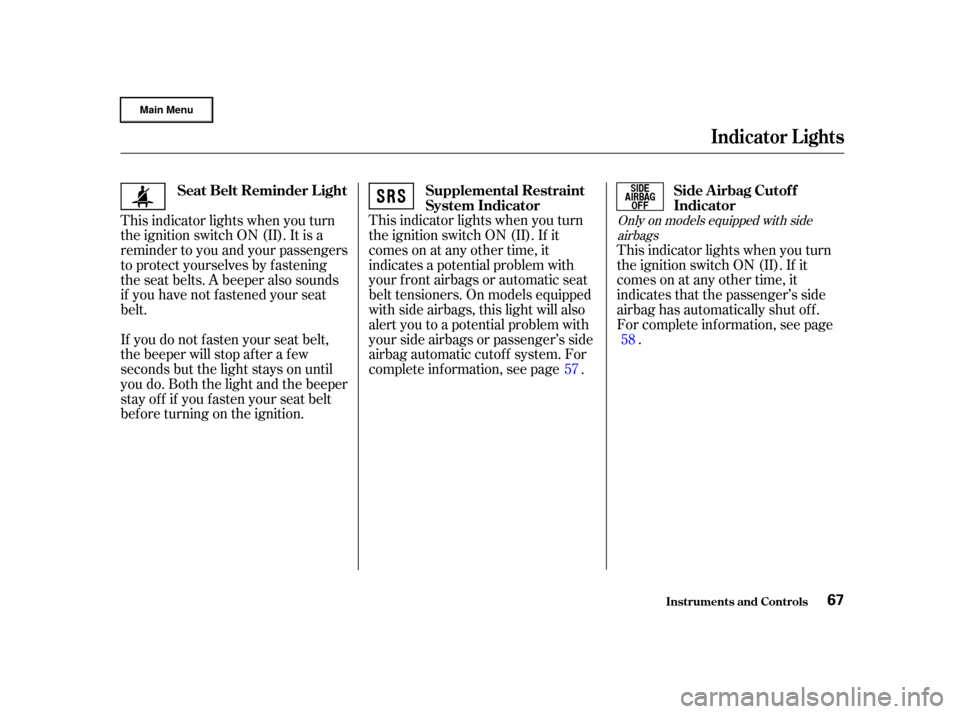
This indicator lights when you turn
the ignition switch ON (II). If it
comes on at any other time, it
indicates that the passenger’s side
airbag has automatically shut off.
For complete inf ormation, see page.
This indicator lights when you turn
the ignition switch ON (II). If it
comes on at any other time, it
indicates a potential problem with
your f ront airbags or automatic seat
belt tensioners. On models equipped
with side airbags, this light will also
alert you to a potential problem with
your side airbags or passenger’s side
airbag automatic cutoff system. For
complete inf ormation, see page .
This indicator lights when you turn
the ignition switch ON (II). It is a
reminder to you and your passengers
to protect yourselves by f astening
the seat belts. A beeper also sounds
if you have not fastened your seat
belt.
If you do not f asten your seat belt,
the beeper will stop af ter a f ew
seconds but the light stays on until
you do. Both the light and the beeper
stay of f if you f asten your seat belt
bef ore turning on the ignition.
58
57
Only on models equipped with side airbags
Indicator L ights
Inst rument s and Cont rols
Supplemental Restraint
System Indicator Side A irbag Cutof f
Indicator
Seat Belt Reminder L ight
67